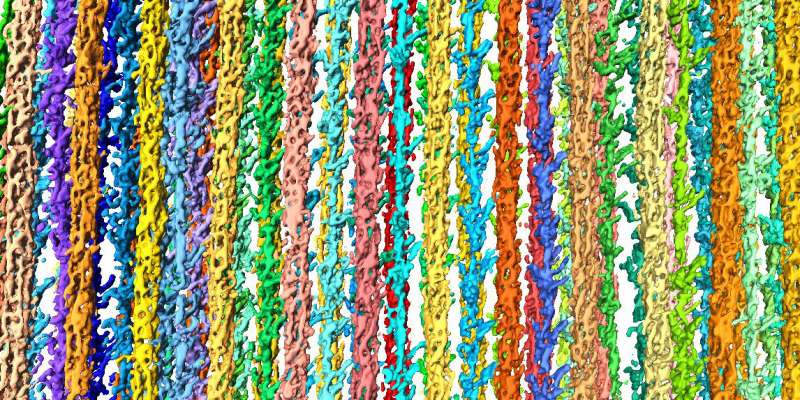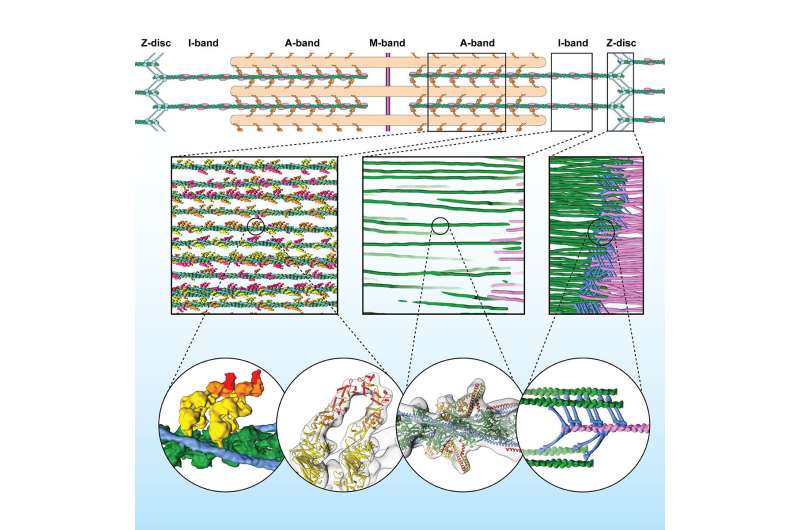Zooming in on muscle cells has produced the first high-resolution 3D image of the sarcomere

An international team, led by Stefan Raunser, Director at the Max Planck Institute of Molecular Physiology in Dortmund, in collaboration with Mathias Gautel at the King's College in London, has produced the first high-resolution 3D image of the sarcomere, the basic contractile unit of skeletal and heart muscle cells, by using electron cryo-tomography. Electron cryo-tomography capability of imaging structures directly in frozen muscle cells could translate into future medical treatments for muscle diseases and a better understanding of the aging process.
Sarcomeres are small repeating subunits of myofibrils, the long cylinders that bundle together to make the muscle fibers. Inside the sarcomeres, filaments of the proteins myosin and actin interact to generate muscle contraction and relaxation. So far, traditional experimental approaches to investigate the structure and function of muscle tissue were performed on reconstructed protein complexes or suffered from low resolution. "Electron cryo-tomography, instead, allows us to obtain detailed and artifact-free 3D images of the frozen muscle," says Raunser.
Electron cryo-tomography was for a long time an established yet niche methodology. But recent technical advances in electron cryo-microscopy as well as the new development of cryo focused ion beam (FIB) milling are pushing electron cryo-tomography resolution. Similar to electron cryo-microscopy, researchers flash-freeze the biological sample at a very low temperature (- 175 °C). Through this process, the sample preserves its hydration and fine structure and remains close to its native state. FIB milling is then applied to shave away extra material and obtain an ideal thickness of around 100 nanometers for the transmission electron microscope, which acquires multiple images as the sample is tilted along an axis. Finally, computational methods reconstruct a three-dimensional picture at high resolution.
Raunser's team performed electron cryo-tomography on mouse myofibrils isolated at the King's College, and obtained a resolution of one nanometer (a millionth of a millimeter, enough to see fine structures within a protein): "We can now look at a myofibril with details thought unimaginable only four years ago. It's fascinating!", says Raunser.
Fibers in their natural context
The calculated reconstruction of the myofibrils revealed the three-dimensional organization of the sarcomere, including the sub regions M-, A-, and I- bands, and the Z-disc, which unexpectedly forms a more irregular mesh and adopts different conformations. The scientists used a sample with myosin strongly bound to actin, representing a stage of the contracting muscle that is called the rigor state. And indeed, they could visualize for the first time in the native cell how two heads of the same myosin bind to an actin filament. They also discovered that the double head not only interacts with the same actin filament but is also found split between two actin filaments. This has never been seen before and shows that proximity to the next actin filament is stronger than the cooperative effect between the neighboring heads.

"This is just the beginning. Electron cryo-tomography is moving from niche to widespread technology in structural biology," says Raunser. "Soon we will be able to investigate muscle diseases at molecular and even atomic level." Mouse muscles are very similar to those of humans, yet scientists plan to investigate muscle tissue from biopsies or derived from pluripotent stem cells.
More information: The molecular basis for sarcomere organization in vertebrate skeletal muscle. Cell. DOI: 10.1016/j.cell.2021.02.047
Journal information: Cell
Provided by Max Planck Society




















